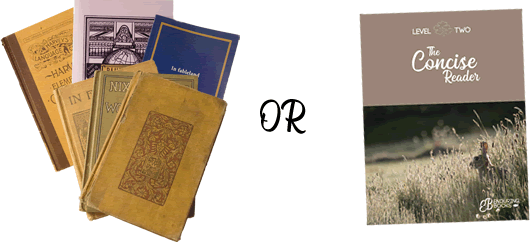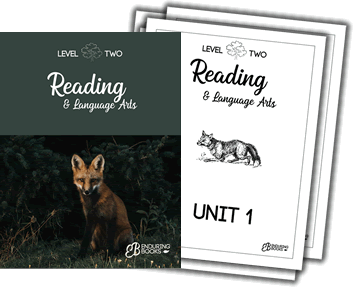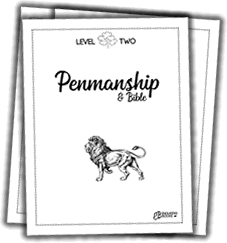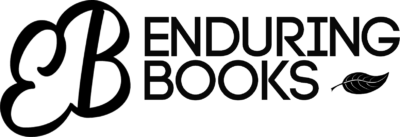Level Overview
Who: students who have mastered phonics and can read correctly if not swiftly. This curriculum does not cover phonics.
What: Full curriculum for reading, comprehension, vocabulary, grammar, spelling, composition, and penmanship. Includes art and geography extension activities and covers some science and history content.
How: 180 days of instruction in 9 printable packets. The curriculum is designed to be moving toward independence. There is no teacher manual; all the instruction is in the book. (There is a separate answer key.)
The Cores

What you need: You need the primary cores. There are three different ways you can get the primary cores:
- Use digital versions of the full books, either by printing or on a tablet or similar device. All books are on Google Books (and other places).
- Buy copies of the printed books. Ebay, Amazon, etc. I tried to pick cores that are still widely available. I have the “white” set of the My Book House series, for example, and it is still in good enough condition to sit down and read it with a six-year-old. I also have a copy of In Fableland, and it’s very clearly over a century old and I would not want to loose a six-year-old upon it. (Good news, though, is that both of those books are also available in facsimile brand-new on Amazon, so you can be sure of a book where the pages aren’t falling out from age.) This option is my recommendation because then you can read the texts in between assignments as an excellent expansion activity. They’re good books!
- Use The Concise Reader. You can print it or use it on a tablet. This is easy, because it only has the selections in it that are in the curriculum, and they are in order, etc. However, you’re missing a lot of good stuff that was in the original books. Still, I include it for those “on the move” or otherwise constrained.
The Curriculum

The meat of EB is found in the Reading Units. You can currently download them individually and print them, but once they are all complete, you should be able to order a print-on-demand book to get them all in one spot if that works better for you.

The Book of Characters is an essential part of Unit 1.
The Penmanship books are a set of three (one per three Reading units) that include Bible verses that tie into the Reading lessons.

How to get started: the workbook has all the instruction you need. Print workbook 1, My Vocabulary Book, and My Penmanship Book, grab the first core (In Fableland) and just open it up and go. One small caveat: although the workbooks are designed for independence, there’s a limit to this with seven-year-olds in mind! In the beginning, in particular, there is a LOT of written instruction in the lesson that they will almost certainly need help wading through. Rest assured that the curriculum becomes more and more independent as the student moves through. You may also notice a little leaf emblem which indicates that the subject is NEW and might need a little extra teaching help from you, or a green apple which means even an independent, motivated student needs your help (to administer a spelling test, etc.). It’s also worth noting that spelling is grouped phonetically when possible, and you should help your student discover the patterns in words so that they can learn the pattern and all the words therein rather than learning each word separately. Please also see this detailed post about spelling.
The website: if you start each day with the corresponding blog post (here’s Day 1), you get a little bit of teacher notes despite my best intentions, and, more importantly, links to audio files and other extra resources that don’t fit well in a workbook or printed format.
Downloads
- Units 2-9
- Answer Key
- My Penmanship Journal — note that this is explicitly Christian; the penmanship selections are Bible verses designed to elucidate or provoke conversations about the day’s text. They’re carefully correlated.
- The Supplemental Reader, Level 2 — includes the supplemental reading only
If you don’t have ANY cores, you need The Concise Reader. If you only have the main three cores, you still need The Supplemental Reader.
Cores
- In Fableland, by Emma Serl — these simple stories form the backbone of unit 1, which covers fables, narration, oral storytellng, compare/contrast, and discussion. In Fableland is a lovely retelling of Aesop’s fables, written in easy English, and, more importantly, they tell one singular coherent story (i.e. the wolf is consistent from story to story) rather than short separate little unrelated tales.
- My Book House, Volume 1 (original edition) or Volume 2 (of 12–the newer editions) — more traditional tales form the backbone of units 2 and 3, and some opportunities to look at fables again, and compare/contrast different tellings.
- Graded Literature Readers: Third Book — real literature explored in units 4-9.
Note: future grades will almost certainly be a blend of the Graded Literature Readers and the Elson Readers. Both are literature-based readers.
Supplemental
- Grammar-land by M.L. Nesbitt – included in Workbooks
- “Famous Men” by John H. Haaren – included Supplemental Reader
- Prang’s Natural History Series for Children: Birds of Prey – included in Supplemental Reader

